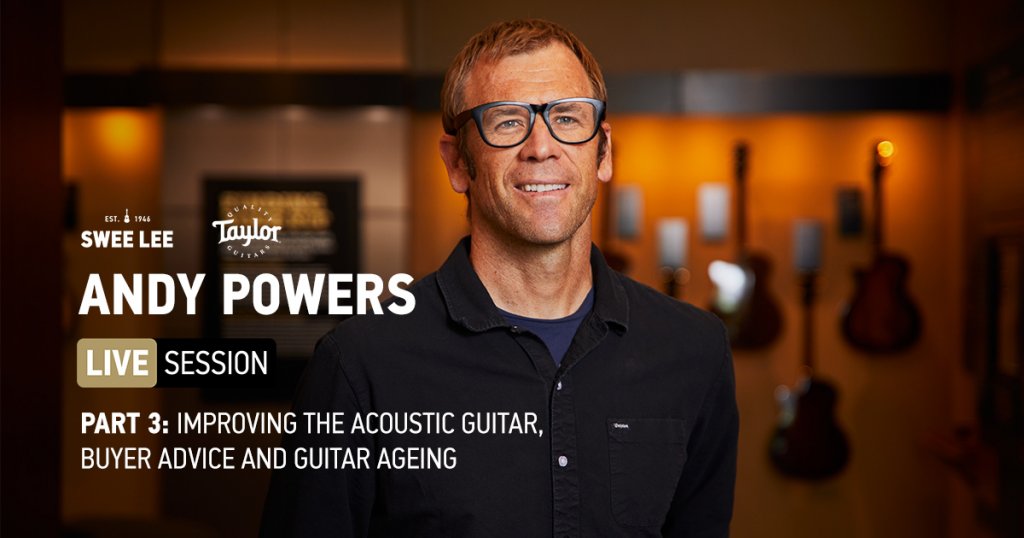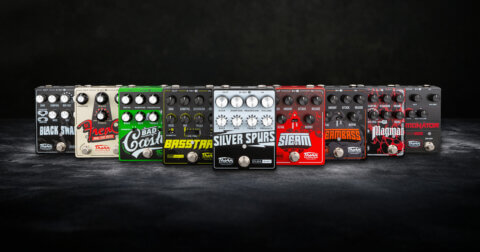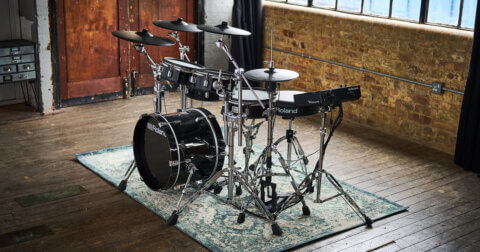We’re finally on to our last instalment of the incredible learning journey with Taylor’s Master Guitar Designer Andy Powers. Andy had covered topics ranging from sustainability to wood selection to working from home during the pandemic, and today we’ll be diving into even more topics about the acoustic guitar he knows so well.
Make sure you don’t miss out on the earlier parts of our live session with Andy Powers. You can read part 1 here and part 2 here.
The saying goes “form follows function”. Does the traditional form of acoustic guitar so perfect, that it cannot be improved? What can be done to make it even better as an instrument?
Largely, most guitars take on the shape of a figure 8. But I would say that design has not been perfected, it is not set in stone. If you were to look at acoustic guitars over the last hundred years, look how many different shapes have been made. You have everything from small parlor guitars – that can sound beautiful – to a big giant jumbo or dreadnought guitar with a radically different set of curves.
One of the really interesting design choices that you make when building guitars is that curves that form that profile – those matter a great deal in determining how the guitar sounds. If you took a ruler and measured the size of the guitar top – maybe it’s a 16″ wide guitar and the body is 20” long. Within those measurements, there are an infinite variable number of guitars you can make. Maybe the lower bout has a broader or skinnier curve, maybe it’s a little wider or narrower at the waist. All of those things matter.
The curve of those shapes determines how much air is inside the guitar. The air mass inside the guitar is important for determining the overall resonance and response of the instrument. Take a soda bottle, and if you blow over the top, you’re listening to what is called the Helmholtz resonance. That’s the pitch of the air that is inside the bottle. If we change the shape of the guitar, that air, of course, will change, so you’re changing those frequencies.
The other aspect that is really significant, is that the sides of the guitar are forming a boundary edge for the vibrating top and back – it’s almost like changing the shape of your drum as you hit it. So you can imagine how different sized drums will respond with different tones based on its size and shape. A guitar is no different. The extremeness of those curves and determine how stiff the edges of the top are. They act like the wall that is holding up your roof.
There are a lot of physical factors at play that go into the design and shape, but I’ll say that there are a number of different guitars that still have not been made, just by changing that outline itself. I think there are a lot of fun new guitars that we are still yet to make! Different shapes and sizes, including the different bracing architecture that you can work with. There are all sorts of different and fun things we can get to do!
As a luthier, can you tell us what are some of the hidden aspects of an acoustic guitar that guitar buyers should be looking out for, especially those that are not displayed on spec sheets and marketing materials?
You’re right, as a luthier, there are things that I do look for. When you look at specifications, they’re a helpful point of reference. But to me as a player, even more so as a builder, that doesn’t tell me very much about what the guitar is, how it works, how it sounds, or how it feels.
I personally love to actually play the guitar. The tactile aspect of wrapping your hand around the neck, feeling the strings, feeling the way the body moves, how it responds to your unique playing style – to me that’s very important. When I go to look at a guitar, one of the first things I will look out for is fretwork. Honestly, a really good playing neck is a neck that is straight with a type of geometry you want to see – it won’t be perfectly straight, it should have just the right amount of curvature and relief at the right places – and with really clean fretwork. I want to see a fingerboard that’s accurate and frets that are good. No matter how well the guitar is built, no matter how good it sounds, if it doesn’t play well with accurate frets, I really don’t care. Because I’m not going to be able to make it sound good until those things are corrected.
So I want to see a guitar that is set up well, comfortable string height, comfortable action, great fret job, a good accurate playing neck. Past that, I want to look at some of the interior construction details. I’ll take a glance through the sound hole, I’ll take a look at how clean the workmanship is. Are there broken looking pieces? Is it crude and rough? Details like that give you an insight of the level that the builder is working at.
But more importantly, if the guitar is fun to play, sounds good, if it makes an appealing sound for the music you play, and you enjoy playing it – those are the characteristics that make it a good instrument.
One of the more traditional measurements that builders use – almost like a calling card that they use – is they look at the binding are purfling details. That was traditionally done by hand – in our factory it still is done by hand – so those details are very carefully executed. That meant that the builder, or at least the manufacturer was paying close attention to those details. If you see things that are real uneven, rough, poorly fit together, gaps that were puttied over – as a builder I’ll see stuff like that and go, “you know you’re sweeping some details under the rug and hoping nobody notices!” Those are more craftsmanship level details that I like to look for.
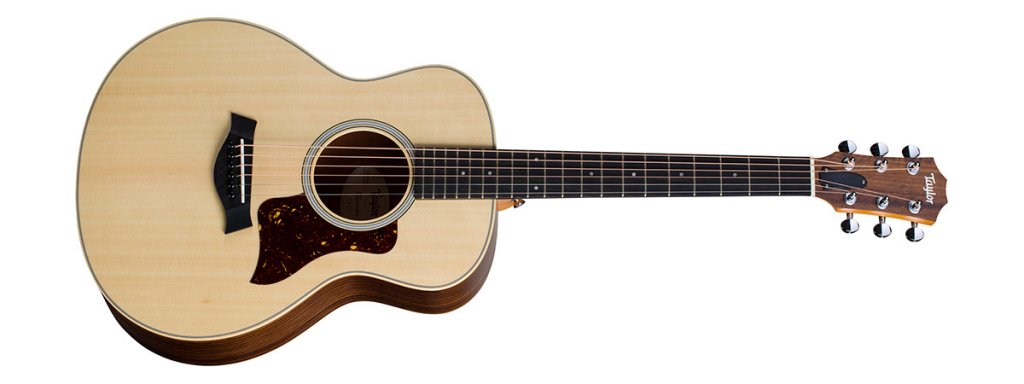
But more importantly, if the guitar is fun to play, sounds good, if it makes an appealing sound for the music you play, and you enjoy playing it – those are the characteristics that make it a good instrument. There are instruments that I’ve played that had no right to sound as good as they did! I’ve seen some instruments that were so crudely and primitively made, maybe with bad repairs made over the years, and somehow once in a while you’ll find those instruments that are miraculously good sounding. If it sounds great, is fun to play, it is a great instrument. For me there’s a big balancing act between wanting to play that guitar, but from a builder’s perspective, I’ll look at those things I’ve mentioned before.
As you play a guitar over time, the tone improves over time. Just like how a fine wine ages with time. Could you explain how that actually works?
That’s actually a very complex process because there is no one single factor that contributes to it. Here’s a simple analogy – let’s say you think of a fresh, crisp, brand new dollar bill. Now you fold it up and put it in your pocket, you buy a cup of coffee with it and it goes from hand to hand, folded, wrinkled, straightened out, bent. Eventually, the crisp bill will take on the texture of a piece of cloth. You see a very old worn out bill, its fibres, usually a cotton based fibre, will slowly break down and become more flexible.
Wood will also go through the same process. As it vibrates and responds to what you are playing, it slowly becomes more able to resonate in those same ways. We say that the guitar is loosening up, it becomes more relaxed and more freely responsive to what you do with the strings.
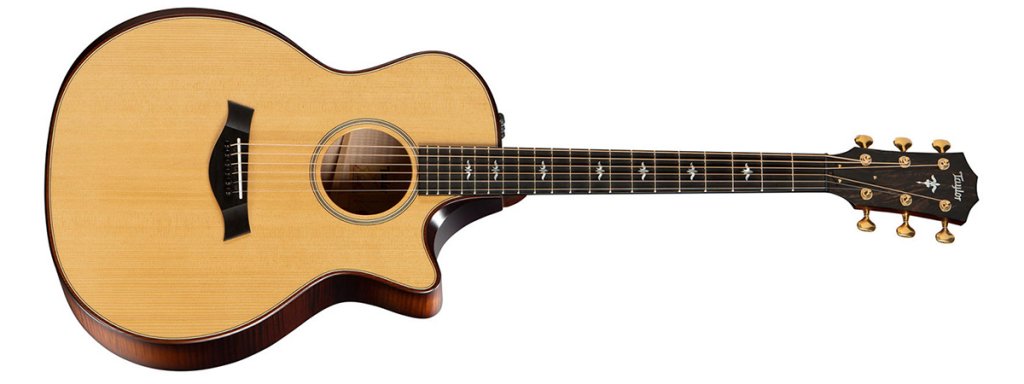
As an interesting counterpoint to that, when the wood ages, it slowly can develop a little additional resilience. It’s one of the effects that is being accelerated with torrefaction and heat treating on woods. It’s an interesting process where a piece of wood is slowly broken down on a microscopic level and becomes more able to vibrate freely as well as taking on increased resilience in the form of a strung up, under tension guitar. The more you play the guitar, the more it is able to offer and replicate what the strings are doing with it. It’s really fascinating! The instrument is one of the only objects I can think of that gets better the more it’s used. Maybe you’ve got a favourite cooking pan that gets better with every use or a baseball mitt – but there are very few things where the more you use it the better it works. The guitar is really unique in that way.
It had been an immense honour and pleasure to have hosted a massively talented and respected luthier in Andy Powers. We want to thank Andy and of course Taylor Guitars for giving all of us this fantastic opportunity to learn from one of the guitar industry’s best.
Check out our entire collection of Taylor Guitars on our online store here. Or head down to your nearest Swee Lee store to give these great guitars a try.
